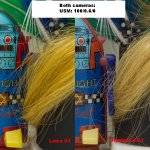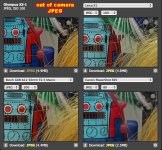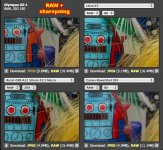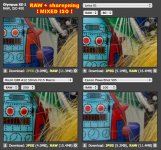OK - as mentioned
HERE I had the chance to compare X1 and GXR side by side (click on the link to see my impressions)
As in this game I did not only consider APS-C cameras but also P&S I decided to have a few test photos (studio shots from dpreview) printed to see how these camera compare on photo-paper.
Cameras selected:
- Olympux XZ-1, Leica X1, Ricoh GXR with A12 (50 mm) and Sigma DP2.
Prints:
- when possible I tried to get RAW files from dpreview at base ISO and higher ISO (3200 for X1 and GXR and 400 for XZ-1).
- I kept the native resolution such that I printed it at 360 dpi. This yielded about A4 prints for X1 and GXR, slightly smaller for XZ-1 and considerably smaller for DP2 (which I may have scaled up a bit as it is a Foveon sensor)
Post Processing:
->
LOW ISO:
- for X1, GXR, SD2 - direct conversion with no sharpening or color adjustments with CS3 and subsequesntly applying Smart Sharpening with amount of 100 and radius 0.3, settings: Lens Blur
- for XZ-1 - Used JPEG from DPreview (I was not able to open correctly the RAW - the camera is too new for CS3). I did apply additional Smart Sharpen of amount 100 and radius 0.5. I probably should not have doe this as on the DPreview the image was already sharpened. Followed by a noise suppression with CS3.
->
HIGH ISO: 3200 for X1 and GXR and 400 for XZ-1 on top of what I have done for LOW ISO I also applied noise suppression in PS (pretty much the default settings of CS3) what does a reasonable job. Of course the XZ-1 did NOT get the noise suppression twice.
LOW ISO impressions: (I ignore color differences here)
-
X1 and GXR look pretty much indistinguishable. Any faint differences would be easy to shift to one or other side with PP
-
DP2- clean and very detailed. While the detail per pixel is very high - it can barely be seen at this 360 spi print. It would be more fair to print at 240 dpi. I did this comparison on screen and at that point the image file was not as clean and sharp as X1 or GXR. The DP2 could match some 8 Mpix Bayer sensor, but not 12 Mpix.
-
XZ-1 - as mentioned above - it got
double sharpening. This yielded print that is definitely sharper that the one from X1 or GXR - but it still does not look oversharpened! Without any doubt I can see in the print finer detail than I do with either X1 or GXR (both at abse ISO) !!! That is to me hard to understand.
** Sanity check ** (Attachment
Nr. 1, 2, 3)
So - before going to HIGH ISO I went back to DPreview and check the files. Indeed if you open the review of XZ-1 and go to JPEG and then to RAW comparison - it can be clearly seen that while the XZ-1 RAW output shows noise at base ISO - the image simply shows more detail. Now that IS puzzling to me. Now - I would not make too strong conclusion on this as one should indeed compare him/her self. My only point would be - the XZ-1 is capable of VERY detailed images at low ISO and with some more advanced noise suppression nice prints beyond A4 should be no problem.
HIGH ISO impressions (again, color aside):
-
X1 and GXR - very similar again - X1 files may look very slightly better with fine detail, but this is hair splitting. Noise and shadow detail is pretty much the same for both.
-
DP2 - I did not print. Up to ISO 400 the digital files look good and then the color starts to shift. So - no info here
-
XZ-1 - the same story as above - the RAW file is very detailed. It is not possible to suppress the noise without destroying the details, so the print shows the noise. Again - the fine detail is VERY good -
still rivals both X1 and GXR at thei base ISOs !!!
** Sanity check II ** (Attachment
No. 4 - separate post)
So I went back to DPreview and in the page for the review of XZ-1 (RAW comparisons) and selected ISO 400 for XZ-1 and the base iso for rest of the cameras. Again - the XZ-1 while noisy delivers unbeatable detail.
My conclusions:
- X1 and GXR offer image wise nearly the same performance. Probably not a surprise as the sensor is with good probability the same (or at least very similar)
- DP2 - produces very natural images, but the upper limit for prints will probably be around A4 (8x10").
- XZ-1 - is a small camera with very high potential. Delivers good JPEGs and very detailed RAW files. It produced the best looking prints at low ISO from this small group, but this I also assign to over-saturated images from X1 and GXR. But I invested NO time to prcess the RAW files properly - so take that into account. Still - It was very nice to see that compact cameras are capable of such output. Still - this particular scene does not show possible problems like highlight clipping or aberrations. It does not replace real life photos.
Outcome:
- I will have a few more photos printed - for the future I will slightly upsize the XZ-1 files to mach the X1 and GXR (basically the difference between 10 and 12 Mpix). I will also try the same with DP2.
- What concerns the camera selection - I will anyhow wait for the X100, but now I fear less to try it with compact camera - the XZ-1.





